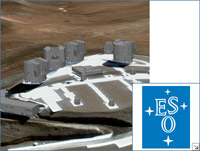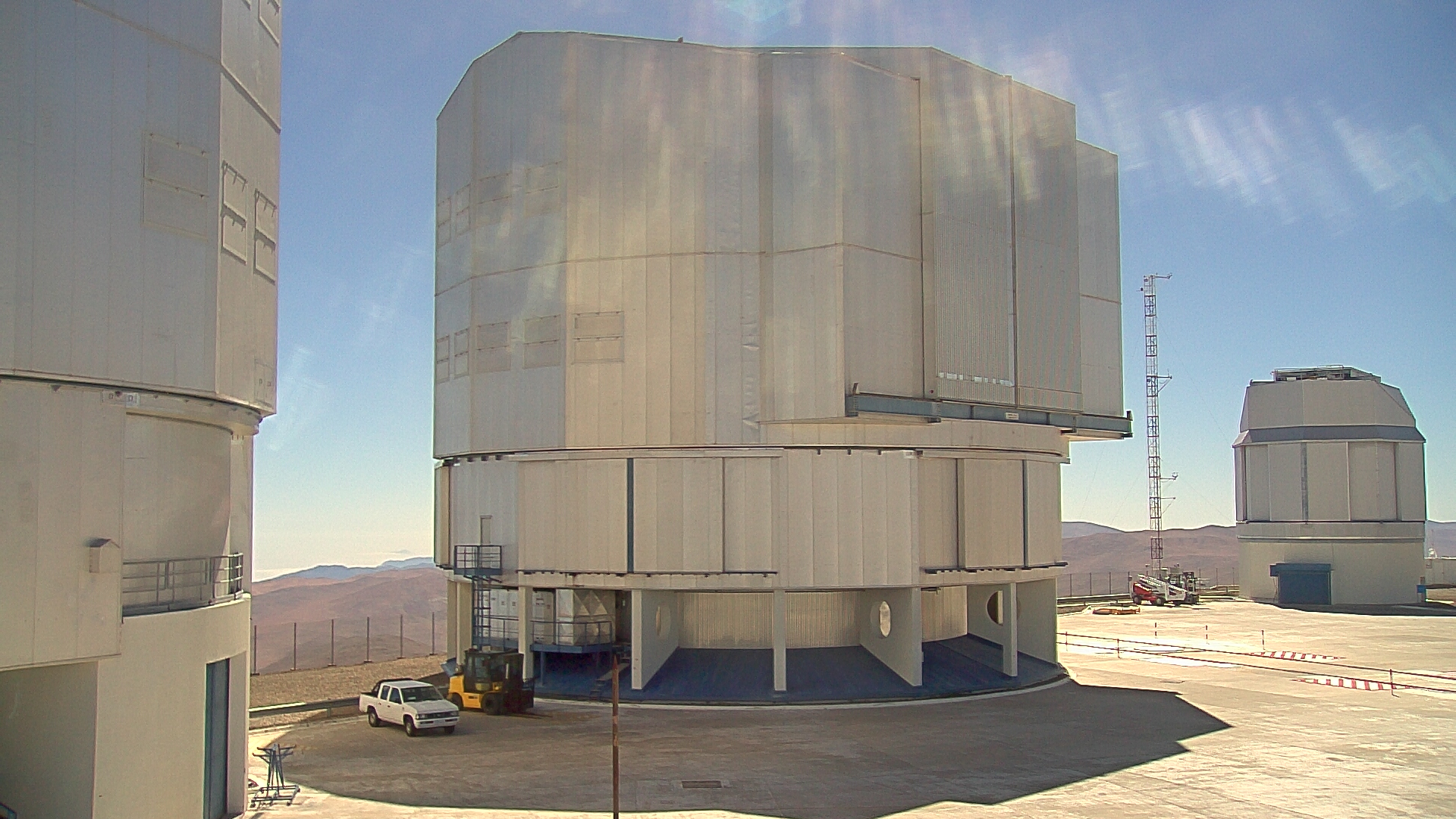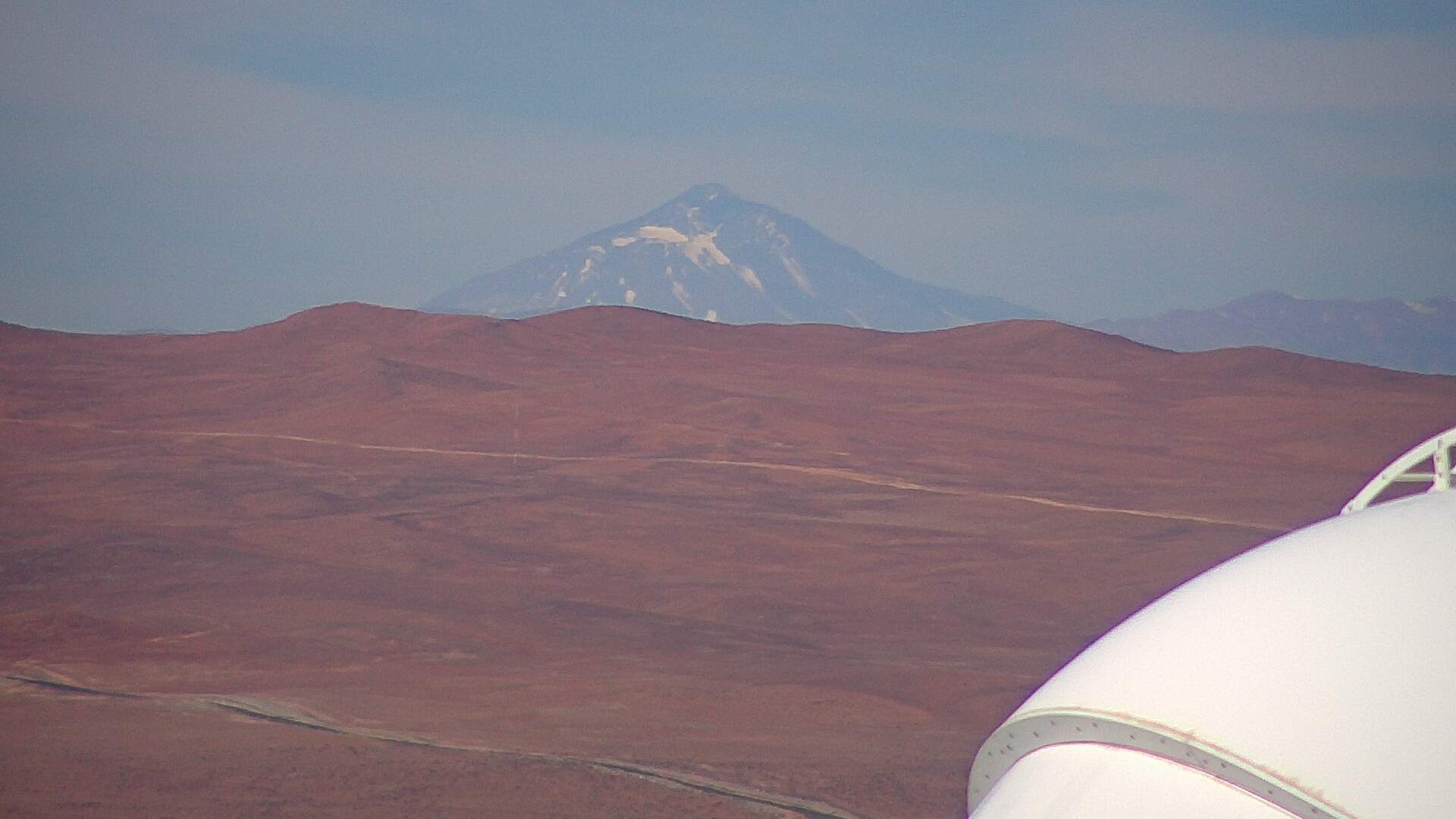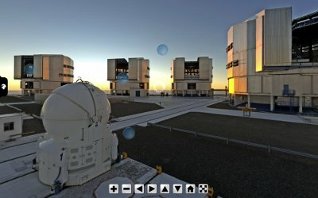Very Large Telescope
El observatorio astronómico de luz visible más avanzado del mundo
Última imagen panorámica disponible de Paranal ()
Las cámaras web se encuentran actualmente en mantenimiento y estarán en funcionamiento a la brevedad.
El conjunto del Very Large Telescope (VLT) es, hasta el momento, el buque insignia de la astronomía terrestre europea de nuestra era. Es el instrumento óptico más avanzado del mundo. Consta de cuatro Telescopios Unitarios (Unit Telescopes, UTs) con espejo primario de 8,2 metros de diámetro más cuatro Telescopios Auxiliares (Auxiliary Telescopes, ATs) móviles de 1,8 metros de diámetro. Los telescopios pueden funcionar conjuntamente para formar un "interferómetro" gigante, el VLT Interferometer o VLTI, que permite ver detalles con 25 veces más precisión que con telescopios individuales de mayor tamaño. Los haces de luz se combinan en el VTLI utilizando un complejo sistema de espejos situados en túneles subterráneos donde las trayectorias de luz deben mantenerse iguales, alineándose con una precisión de 1/1000 mm en distancias de unos 100 m. Con este tipo de precisión, el VLTI puede reconstruir imágenes con una resolución angular de milisegundos de arco, lo que equivaldría a distinguir los dos faros de un vehículo a una distancia similar a la que separa a la Tierra de la Luna.
Los Telescopios de 8,2 metros de diámetro también pueden utilizarse individualmente. Con uno de ellos, se pueden obtener imágenes de objetos celestes muy débiles, llegando a la magnitud 30 tras una hora de exposición. Esto equivale a poder ver objetos que son cuatro mil millones de veces más débiles que el límite detectable por el ojo humano.
Los grandes telescopios se llaman Antu, Kueyen, Melipal y Yepun.
LIVE webcam
LIVE image of MELIPAL, also known as UT3 ()
On extremely clear days the magnificent 6739-metre volcano Llullaillaco is visible in the background of this photograph. It is an amazing 190 kilometres away on the border with Argentina. ()
Una visita al Observatorio Paranal
|
Pincha en la imagen para dar un Paseo Virtual por el VLT. |
Visite el Observatorio Paranal
- Periodistas, comunicadores científicos y productores, por favor, visiten la página Media Visits
- Turistas, estudiantes y otras visitas, por favor, visite la página Visitas de turistas y estudiantes
Telescopios e Instrumentación
El Programa de instrumentación del VLT es el más ambicioso jamás concebido para un solo observatorio. Incluye cámaras multibanda de gran campo, cámaras y espectrógrafos equipados con óptica adaptativa, así como espectrógrafos multiobjeto de alta resolución. El conjunto de instrumentos cubre un amplio intervalo espectral, con longitudes de onda que van del ultravioleta profundo (300 nm) hasta el infrarrojo medio (20 micrómetros).
Los telescopios Unitarios
Cada uno de los telescopios de 8,2 metros de diámetro está ubicado en compactos edificios con control térmico que rotan a la vez que los telescopios, de manera sincronizada. Este diseño minimiza los efectos adversos en las condiciones de observación, como por ejemplo, los debidos a las turbulencias en el interior del tubo del telescopio, al reducir sus causas que podrían darse debido a variaciones en la temperatura y al flujo del viento.
El primero de los telescopios, "Antu", comenzó sus operaciones científicas el 1 de abril de 1999. Hoy en día están operativos los cuatro Telescopios Principales y los cuatro Telescopios Auxiliares.
Los Telescopios Auxiliares
Los cuatro Telescopios Principales del VLT, de 8,2 m cada uno, pueden combinarse para formar el VLTI, pero durante la mayor parte del tiempo se usan por separado, para otros fines. Tan sólo se dispone de un número limitado de noches al año para observaciones interferométricas. Sin embargo, los cuatro Telescopios Auxiliares (Auxiliary Telescopes, AT) de 1,8 m, están disponibles para permitir que el VLTI opere cada noche.
Ciencia con los VLT
 El VLT ha provocado un impacto indiscutible en la astronomía observacional. Es la instalación terrestre individual más productiva y, por promedio, sus resultados han generado más de un trabajo publicado al día en revistas científicas de alto nivel. El VLT contribuye enormemente a hacer de ESO el observatorio terrestre más productivo del mundo, estimulando una nueva era de descubrimientos, con varias primicias científicas destacables, incluyendo la primera imagen de un planeta extrasolar (Ver noticia...), el seguimiento de estrellas individuales moviéndose alrededor del agujero negro súper masivo ubicado en el centro de la Vía Láctea (Ver noticia...), y la observación del resplandor de la explosión de rayos gamma más lejana que se haya conocido.
El VLT ha provocado un impacto indiscutible en la astronomía observacional. Es la instalación terrestre individual más productiva y, por promedio, sus resultados han generado más de un trabajo publicado al día en revistas científicas de alto nivel. El VLT contribuye enormemente a hacer de ESO el observatorio terrestre más productivo del mundo, estimulando una nueva era de descubrimientos, con varias primicias científicas destacables, incluyendo la primera imagen de un planeta extrasolar (Ver noticia...), el seguimiento de estrellas individuales moviéndose alrededor del agujero negro súper masivo ubicado en el centro de la Vía Láctea (Ver noticia...), y la observación del resplandor de la explosión de rayos gamma más lejana que se haya conocido.
Objetivos científicos
Objetivo general de un telescopio de gran apertura óptico-infrarrojo. Las aplcaciones incluyen galaxias con alto desplazamiento al rojo, formación estelar, exoplanetas y sistemas protoplanetarios.
Más sobre ciencia con el VLT
- Ciencia con los telescopios de ESO
- Los diez descubrimientos más importantes de ESO, n° 1, 3, 4, 5, 6, 7, 8 (también disponibles como presentación)
Más sobre el Very Large Telescope
- Más datos interesantes en las FAQs (preguntas frecuentes, en inglés)
- Más imágenes y vídeosen el archivo multimedia de ESO
- Para investigadores: si desea información más detallada, por favor, visite nuestras páginas técnicas
Residencia
El hotel del VLT, la Residencia, es un edificio galardonado y que se utilizó como telón de fondo para la grabación de parte de la película de James Bond Quantum of Solace.
Trailer del VLT
Descarga el trailer del VLT en el archivo de vídeo.
VLT
|
El VLT en Google maps

Descarga los modelos 3D de los telescopios para verlos en Google earth (kmz file, 4.8MB)



